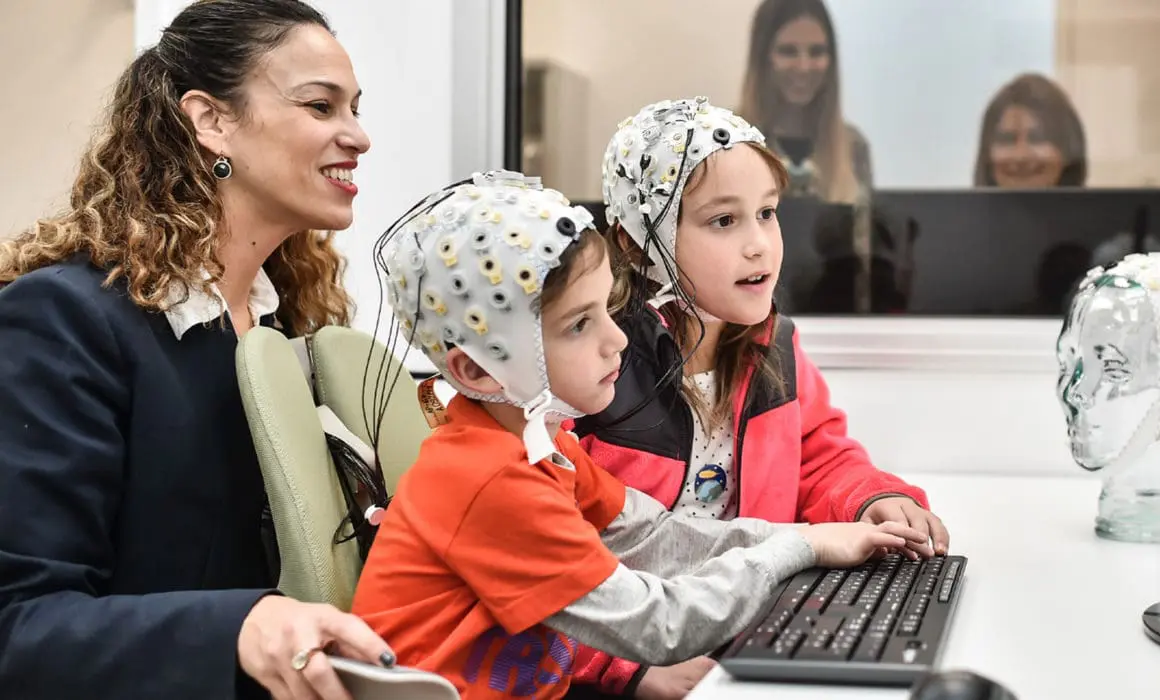She’s Got Reading Difficulties on the Brain

With Assistant Professor Tzipi Horowitz-Kraus
Assistant Professor Tzipi Horowitz-Kraus’ lab is equipped with a state-of-the-art electroencephalogram (EEG) and a waiting room strewn with dolls, crayons, and toys. The toys make young children feel comfortable; the EEG assesses whether those same kids are bound for reading difficulties.
“Reading is not a normal activity for us humans,” says Prof. Horowitz-Kraus, director of the Educational Neuroimaging Center in the Technion Faculties of Education in Science and Technology, and Biomedical Engineering. “When you don’t have any problems with it, you think it’s super easy and you can capture it in the snap of a finger. But for many kids, reading is not an intuitive process.”
That’s where the EEG and other sophisticated neuroimaging tools come in. By attaching electrodes to the head, Prof. Horowitz-Kraus is getting a look inside the children’s brains. What happens in there when a child struggles to read? What happens even beforehand, when the child is not reading but just hearing the words? Her work is unique in using neuroimaging to understand the biology that underlies reading ability. “What regions of the brain does it involve? What networks does it affect? Reading is not just looking at the word and saying it out loud.”
Prof. Horowitz-Kraus had two younger brothers who wrestled with reading problems. Determined to find the neurobiological causes for reading difficulties, which affect about 15% of the population in the U.S., she is trying to isolate the brain circuitry necessary for fluent reading. She works with teens and children as young as four. The younger ones “don’t know how to read yet, but the infrastructure for doing so should be there.”
People struggle with reading for a variety of biological and environmental reasons including psychiatric disorders, dyslexia, and ADHD, to name a few. Reading can be inhibited because a child was born prematurely or the parent suffers from depression. As these children read or listen to a story, Prof. Horowitz-Kraus notes, different areas of the brain light up than those in the brains of competent readers. Getting to the bottom of why a child might have reading problems can help scientists and even educators tailor their solutions.
Thanks to a National Institutes of Health (NIH) grant to the Technion and Cincinnati Children’s Hospital Medical Center, where she is an associate professor, she has been able to focus on the importance of “executive functions” of reading. These functions are a set of cognitive abilities such as attention, memory, and information processing, and the ability to plan, learn from mistakes, and exhibit self-control. If these functions do not work well, then reading is difficult. If you cannot remember the sound made by “th” or quickly recognize the sound that the letter “C” makes, or sit still long enough to think about all of it, then you cannot read.
Prof. Horowitz-Kraus is currently examining the power of dialogic reading — a method where parents or caregivers engage children with questions that force them to retrieve information. “It seems that reading dialogically to your child improves cognitive control abilities, specifically visual attention to details and linguistic abilities,” she says.
Prof. Horowitz-Kraus’ work could potentially save families time and money. Most children with reading difficulties are not identified until third grade, and then only after repeated academic failures and evaluations. By then, a learning gap has already opened and the child is falling hopelessly behind. A paper recently published by Prof. Horowitz-Kraus demonstrated that six minutes of neurological screening can identify children at risk for reading problems. “We want to be able to diagnose kids objectively for their reading problems, and to point to those at risk of developing difficulties even before their reading is acquired,” she says.
Brain scans can be an unbiased and economical way to assess reading problems. “There’s nothing more objective than a picture of your brain activation and the connection between the relevant regions,” she says. Though Prof. Horowitz-Kraus does not have access to an MRI machine on campus, she uses MRI imaging at her Reading and Literacy Discovery Center in Cincinnati to see in real time what parts of the brain light up, and which parts don’t, when young children are read to.
In that work, the mother of three also discovered that greater exposure to computers, iPads, and cellphones correlates to decreased connections between the region of the brain in charge of recognizing words, visual and language processing, and cognitive control. It’s not a definitive study, but she believes kids should not be using digital screens. “We don’t know what screens are doing to our kids’ brains. This is a major question.”
It’s one that Prof. Horowitz-Kraus hopes to answer — along with how to help all children enjoy reading on their own and fulfill their potential.





